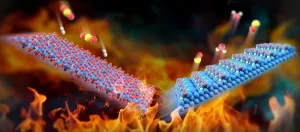(Press-News.org) A group from Nagoya University in Japan has created a new technique for growing the tiny metal nanowires (NWs) that are expected to be used in next-generation electronics. Their results suggest a way to mass produce pure metal NWs, which has until now limited their use. The new technique promises to enhance the efficiency of electronics production, including circuitry, LEDs, and solar cells. The study was published in Science.
Mass production of NWs has been challenging because of the difficulties of scaling production while maintaining quality and purity. NWs are so small that they are made by transporting atoms, the smallest constituent of matter, typically in a gas phase state. However, that is difficult to do with metals, hindering the production of these important components of electronics.
To overcome this problem, a group led by Yasuhiro Kimura at the Nagoya University Graduate School of Engineering used atomic diffusion in a solid phase state enhanced by ion beam irradiation to create aluminum NWs from single crystals.
Atomic diffusion is a process by which atoms or molecules move from areas of high concentration to areas of low concentration, through stress state change under heat. Using ion beams, the crystal grains were irradiated inside the thin aluminum film to coarsen them at the surface layer. This caused changes in stress distribution, guiding atomic flow, and was used as a means of supplying mass atomic feedstocks for NW growth to specific locations. In practice, when heat was applied, there was an upward flow of atoms through the gradient from the fine grains on the bottom to the course ones on top, resulting in mass growth of NWs.
“We increased the density of aluminum NWs from 2x105 NWs per square cm to 180×105 per square cm,” Kimura said. “This achievement paves the way for bottom-up metal NW growth methods, which have so far been grown only accidentally and in small quantities. It can also be extended to other metals in principle.”
The resulting aluminum NWs are expected to be utilized as nanocomponents for sensing devices and optoelectronics due to their unique features, such as a large surface area, good mechanical properties derived from being made from single crystals, and their resistance to natural oxidation.
“We realized mass growth of forest-like metallic NWs using only three key processes: thin film deposition on a substrate, ion beam irradiation, and heating,” Kimura explained. “Our technique solves the urgent need to establish mass production methods, especially in the production of high-performance nanodevices such as gas sensors, biomarkers, and optoelectronic components.”
END
Mass production of metal nanowires possible by breakthrough technique
2024-09-10
ELSE PRESS RELEASES FROM THIS DATE:
Methane emissions are rising faster than ever
2024-09-10
The world has not hit the brakes on methane emissions, a powerful driver of climate change. More than 150 nations have pledged to slash by 30% this decade under a global methane pledge, but new research shows global methane emissions over the past five years have risen faster than ever.
The trend “cannot continue if we are to maintain a habitable climate,” the researchers write in a Sept. 10 perspective article in Environmental Research Letters published alongside data in Earth System Science Data. Both papers are the work of the Global ...
New study to explore novel marker in interstitial lung disease prognosis
2024-09-10
Researchers at the University of Exeter and clinical radiopharmaceutical company Serac Healthcare Ltd are researching a new molecular imaging marker which could help to detect disease progression sooner.
The novel imaging agent 99mTc-maraciclatide has been used to scan the first patient with the aim of evaluating the marker’s potential for predicting interstitial lung disease in a Phase II study titled ‘PRospective Evaluation of Interstitial Lung Disease progression with quantitative CT’ ...
Experimenting with different vapes could be crucial to help people quit smoking
2024-09-10
New research from the University of East Anglia (UEA) found that more than a third of quitters who were given a vape in A&E experimented with different devices bought from shops or online
People who smoke and had little experience with vapes were particularly receptive to an opportunistic approach in a medical setting
The study found that some quitters reduced their vaping significantly within a few months, showing that not everyone who uses an e-cigarette becomes dependent on vaping long-term
Peer-reviewed – Observational Study- People
Experimenting with commercially ...
Long-term exercisers have 'healthier' belly fat
2024-09-10
People with obesity who are long-time exercisers have healthier belly fat tissue and can store fat there more effectively than nonexercisers with obesity, according to a new study from a team of researchers at the University of Michigan.
The research team also grew fat tissue in the lab from cells collected from both exercisers and nonexercisers, and cells from the exercisers developed into a tissue that stored fat more effectively.
"Our findings indicate that in addition to being a means to expend calories, exercising regularly for several months to years seems to modify your fat tissue ...
Gene therapy effective in hereditary blindness
2024-09-10
Bothnia dystrophy is a form of hereditary blindness, prevalent in the region Västerbotten in Sweden. A new study at Karolinska Institutet published in Nature Communications shows that gene therapy can improve vision in patients with the disease.
Bothnia dystrophy occurs mainly in the region Västerbotten in Sweden, but the disease has also been identified in other parts of the world. The disease leads to progressive visual impairment due to the destruction of the visual cells in the retina. It is caused by an inherited genetic mutation ...
Report: Conscientiousness, not willpower, is a reliable predictor of success
2024-09-10
CHAMPAIGN, Ill. — According to two psychologists, the field of psychological science has a problem with the concept of self-control. It has named self-control both a “trait” — a key facet of personality involving attributes like conscientiousness, grit and the ability to tolerate delayed gratification — and a “state,” a fleeting condition that can best be described as willpower. These two concepts are at odds with one another and are often confused, the authors report.
“Self-control is a cherished quality. People who have lots of it are celebrated and seen as morally righteous,” wrote University of Toronto psychology professor Michael Inzlicht ...
Advancing prison safety
2024-09-10
The lead article in the current issue of The Criminologist, written by Nancy Rodriguez, University of California Irvine professor of criminology, law and society, shines a light on the lack of prison violence metrics that could help advance safety.
“For the 800,000 persons currently confined and the 200,000 state and federal correctional officers who work within U.S. prisons, the threat of violence is a routine feature of daily life,” she writes. “Accounts from incarcerated persons and staff detail the ever-present threats ...
Towards a better understanding of epigenetics and dynamic gene silencing and reactivation
2024-09-10
Ikoma, Japan – One of the most fascinating discoveries in biology is that cells have mechanisms for dynamically regulating genetic expression. This ability to promote or restrict the transcription of specific genes without altering the DNA sequences themselves is essential to all forms of life, from single-cell organisms to the most complex plants and animal species.
While our understanding of these so-called epigenetic mechanisms is far from complete, remarkable progress has been made in this field with the understanding of the role of the Polycomb Repressive Complex 2 (PRC2). PRC2 is a protein that, in many plants, binds to specific DNA sequences called polycomb ...
Artificial muscles propel a robotic leg to walk and jump
2024-09-09
Inventors and researchers have been developing robots for almost 70 years. To date, all the machines they have built – whether for factories or elsewhere – have had one thing in common: they are powered by motors, a technology that is already 200 years old. Even walking robots feature arms and legs that are powered by motors, not by muscles as in humans and animals. This in part suggests why they lack the mobility and adaptability of living creatures.
A new muscle-powered robotic leg is not only more energy efficient than a conventional one, it can also perform high jumps and fast movements as well as detect and react to obstacles – ...
Researchers develop reaction-induced molybdenum carbides for efficient carbon dioxide conversion
2024-09-09
Molybdenum (Mo) carbides, known for their unique electronic and structural properties, are considered promising alternatives to noble metal catalysts in heterogeneous catalysis. However, traditional methods for preparing Mo carbides suffer from complex processes, stringent synthesis conditions, challenging crystal regulation, and high energy consumption. Additionally, Mo carbides are susceptible to oxidation and deactivation, which poses a significant barrier to their widespread application.
In a study published in Nature Chemistry, a research group led by Prof. SUN Jian from the Dalian Institute ...







